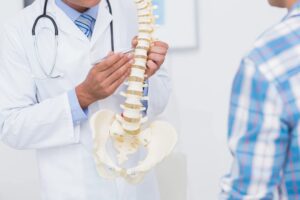
Does chiropractic have research to support its effectiveness? Here are the top 5 research articles that support the effectiveness of evidence-based chiropractic care. These research articles are from some of the top research and chiropractic journals.
1)The WHO(World Health Organization) recommends chiropractic and Spinal Manipulative Therapy
The World Health Organization commissioned an analysis to develop recommendations from high-quality clinical practice guidelines for patients with non-specific low back pain with and without radiculopathy:
“Recommended interventions included:
- Education about recovery expectations, self-management strategies, and maintenance of usual activities.
- Multimodal approaches incorporating education, exercise, and spinal manipulation.
- NSAIDs combined with education in the acute stage.
- Intensive interdisciplinary rehabilitation that includes exercise and cognitive/behavioral interventions for persistent pain.”
2) Chiropractic Treatment of Headaches in Adults
The article titled “Evidence-based guidelines for the chiropractic treatment of adults with headache” by Roland Bryans and colleagues provides recommendations for the chiropractic treatment of headaches in adults based on evidence from controlled clinical trials. Here are the key points:
- The study conducted systematic literature searches of controlled clinical trials relevant to chiropractic practice up to August 2009.
- The evidence was categorized as strong, moderate, limited, or conflicting based on the number, quality, and consistency of findings.
- For migraine headaches, spinal manipulation and multimodal multidisciplinary interventions, including massage, are recommended for management in patients with episodic or chronic migraine.
- For tension-type headaches, spinal manipulation is not recommended for episodic tension-type headache, and no specific recommendation is made for or against spinal manipulation for chronic tension-type headache. Low-load craniocervical mobilization may be beneficial for longer-term management of patients with tension-type headaches.
- For cervicogenic headaches, spinal manipulation is recommended. Joint mobilization or deep neck flexor exercises may also improve symptoms. However, there is no consistent evidence supporting the combined use of joint mobilization and deep neck flexor exercises for cervicogenic headache.
- Adverse events were generally not addressed in most clinical trials, and when they were, they were either absent or minor.
- Chiropractic care, including spinal manipulation, appears to be effective in improving migraine and cervicogenic headaches. However, the use of spinal manipulation as a sole intervention for tension-type headaches remains inconclusive.
In summary, the article provides evidence-based recommendations for chiropractic treatment of various types of headaches in adults, with different recommendations for each headache type based on the available evidence from clinical trials.
3) Benefits and Harms of Spinal Manipulative Therapy (SMT) for the Treatment of Chronic Low Back Pain
This systematic review and meta-analysis by Sidney M. Rubinstein and colleagues aimed to assess the harms and benefits of spinal manipulative therapy (SMT) for the treatment of chronic low back pain. Here’s a summary of the key findings:
- The study analyzed 47 randomized controlled trials involving 9,211 participants, primarily middle-aged individuals (35-60 years).
- SMT was compared with recommended therapies, non-recommended therapies, sham (placebo) SMT, and SMT as an adjuvant therapy.
- Moderate-quality evidence suggested that SMT provides similar short-term pain relief as other recommended therapies and a small, clinically significant improvement in function.
- High-quality evidence suggested that compared to non-recommended therapies, SMT results in small but clinically better effects for short-term pain relief and small to moderate clinically better improvement in function.
- The effects of SMT were consistent for intermediate and long-term outcomes, as well as when used as an adjuvant therapy.
- Evidence for sham SMT was of low to very low quality, making the effects uncertain.
- About half of the studies examined adverse events, which were mostly musculoskeletal-related, transient, and of mild to moderate severity. One study found no increased risk of adverse events compared to sham SMT.
- The Data Safety Monitoring Board judged one serious adverse event to be possibly related to SMT in one study.
In conclusion, the study found that SMT produces similar effects to recommended therapies for chronic low back pain and is better than non-recommended interventions for short-term functional improvement. However, clinicians should inform patients about the potential risks of adverse events associated with SMT.
4) Effectiveness of Chiropractic Treatments for Whiplash-Associated Disorders (WAD) and Neck Pain
The study titled “Are manual therapies, passive physical modalities, or acupuncture effective for the management of patients with whiplash-associated disorders or neck pain and associated disorders?” is an update of the Bone and Joint Decade Task Force on Neck Pain and Its Associated Disorders by the OPTIMa collaboration. The study aimed to assess the effectiveness of various treatments for whiplash-associated disorders (WAD) and neck pain and associated disorders (NAD). Here’s a summary of the key findings:
- The study conducted a systematic review and best evidence synthesis of randomized controlled trials, cohort studies, and case-control studies from 2000 to 2014.
- They identified evidence suggesting that certain interventions are effective for the management of neck pain:
- For recent but not persistent NAD grades I-II, thoracic manipulation provides short-term benefits.
- For persistent NAD grades I-II, the specific technical parameters of cervical mobilization do not significantly impact outcomes, and one session of cervical manipulation is similar to Kinesio Taping.
- For recent NAD grades I-II, Swedish or clinical massage, in addition to self-care advice, adds benefit.
- The study also found that certain treatments are not effective for managing neck pain:
- Strain-counterstrain treatment is not better than placebo for NAD grades I-II.
- Home-based cupping massage and needle acupuncture provide similar outcomes to other interventions for persistent NAD grades I-II.
- Some passive physical modalities like heat, cold, diathermy, hydrotherapy, and ultrasound were found to be ineffective for managing neck pain.
- The review adds new evidence to the Neck Pain Task Force’s findings, suggesting that mobilization, manipulation, and clinical massage are effective interventions for neck pain.
- On the other hand, electroacupuncture, strain-counterstrain, relaxation massage, and certain passive physical modalities were found to be ineffective and should not be used for managing neck pain.
In conclusion, the study provides updated evidence on the effectiveness of various treatments for neck pain, offering insights into which interventions are beneficial and which should be avoided. Making note that Spinal manipulation and mobilization have evidence to support effective interventions for neck pain.
5) Addition of a Self-Acupressure Pillow (SAP) to Typical Chiropractic Treatment for Improvement in Tension-Type Headaches
This study aimed to determine if the addition of a self-acupressure pillow (SAP) to typical chiropractic treatment could lead to greater improvement in tension-type and cervicogenic headache sufferers. Here’s a summary of the key findings:
- The study conducted a randomized clinical trial with 34 subjects who experienced tension-type and cervicogenic headaches, aged 21 to 60 years, and both male and female.
- Group A (n = 15) received typical chiropractic care, which included manual therapy and exercises, while group B (n = 19) received typical chiropractic care along with daily use of the SAP for 4 weeks.
- The main outcome measure was headache frequency. Additionally, satisfaction and relief scores were obtained from subjects in the SAP group.
- The analysis showed that the chiropractic-only group (Group A) achieved a 46% reduction in weekly headache frequency, which was statistically significant.
- In contrast, the group that used the SAP in addition to chiropractic care (Group B) showed less improvement in headache frequency, and this difference was not statistically significant.
- The mean benefit score for the use of the SAP in Group B was 1.2 out of 3, indicating moderate satisfaction.
- Users of the SAP reported a mean satisfaction rating of 10.4 out of 15, representing moderately high satisfaction with its use.
In conclusion, the study suggests that chiropractic care alone may be effective in reducing the frequency of headaches in patients with chronic tension-type and cervicogenic headache. The use of a self-acupressure pillow may provide some headache relief and moderate satisfaction, but it did not result in significantly better outcomes compared to chiropractic care alone.
Check out this informative video on chiropractic- the natural solution:
Frequently Asked Questions:
- What does research state about chiropractic? Most research articles will state that chiropractic is as good or better than most modalities for conditions such as low back pain, neck pain and headaches. In addition, when done appropriately it is extremely safe. In addition this study it showed that chiropractic patients In a random-effects analysis, chiropractic users had a 64% lower odds of receiving an opioid prescription than nonusers
- Why do chiropractors have different techniques? This is a personal thing but all chiropractors use techniques that they feel will benefit their patients to the best of their abilities. Just like massage, there are times when a deep tissue massage may be necessary and other times a more lighter touch massage may be appropriate. It is entirely up to the doctor and the patient to use the most effective and safest technique to get the desired results.
- Do chiropractic adjustments hurt? This is by far the number one question I get asked. In a simple answer; NO they do not hurt. They might feel a little bit strange if you are not used to them but they should never hurt. In addition, there are a multitude of techniques that can be used to lessen the chance of any discomfort. However, a chiropractic adjustment should never hurt.
Dr. David Orlando is the founder of Innovative Health and Wellness. He graduated with honors from Life College of Chiropractic and has been practicing in the greater Atlanta GA area since 1995. He has created his social media series Atl Cracks with Dr. O and has had patients come from all over the world to see him due to his unique and effective approach to chiropractic. Dr. Orlando is passionate about chiropractic and wants to spread the word about the power of chiropractic to the world.


